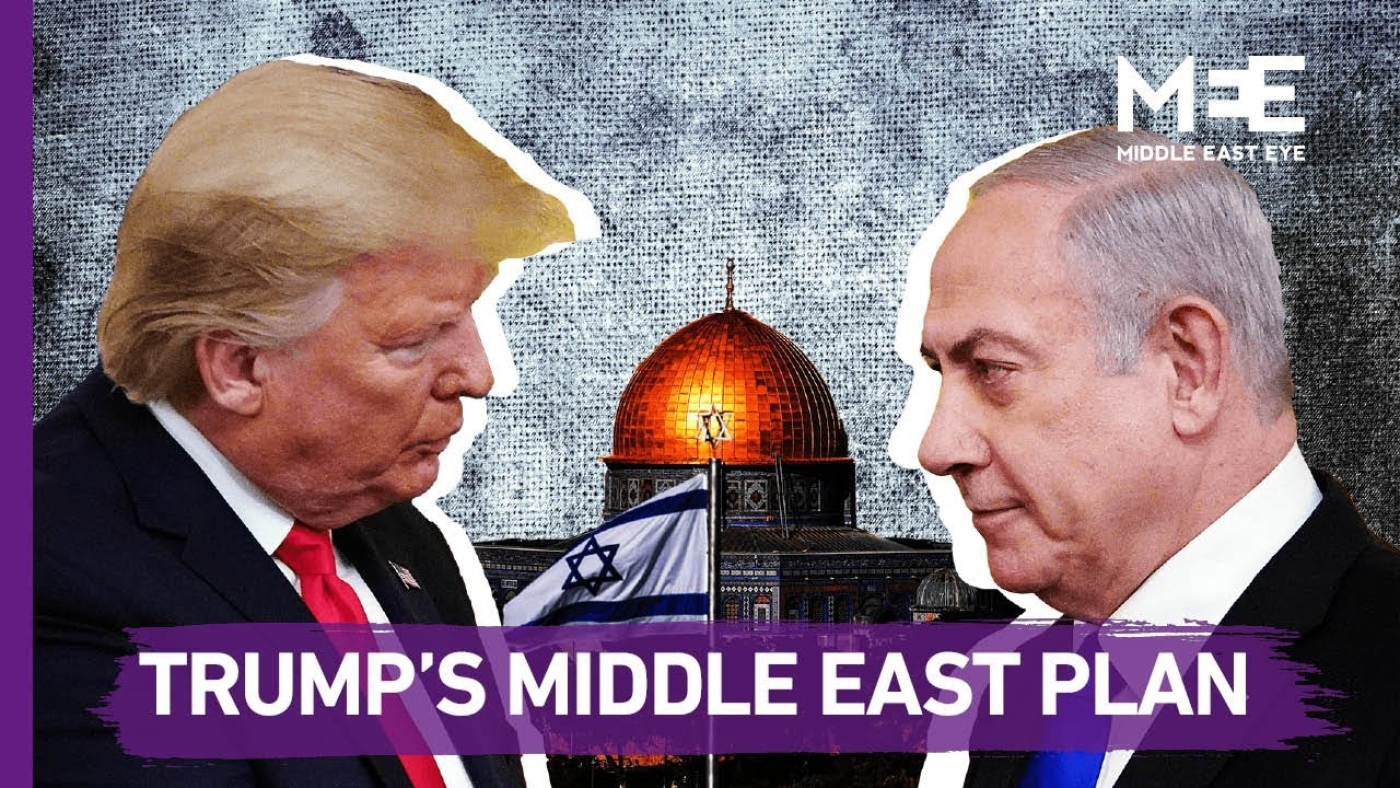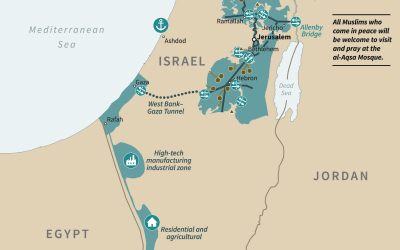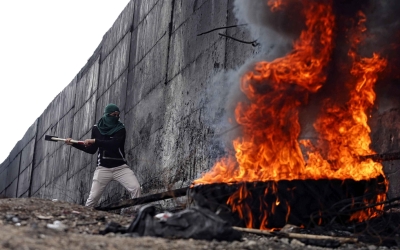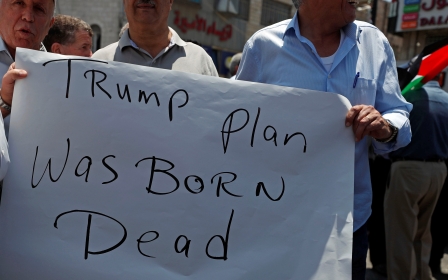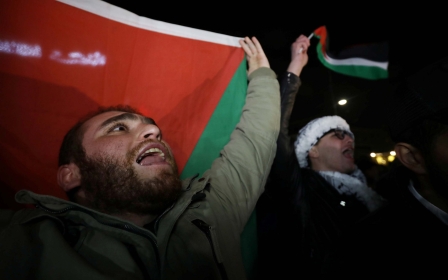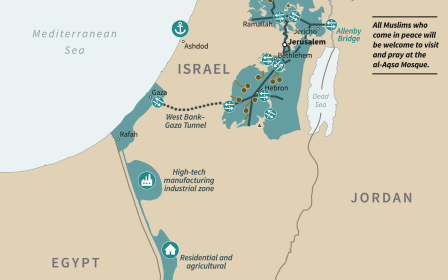Deconstructing the deal: A breakdown of Trump's plan
After a two-year wait for Donald Trump’s Middle East plan to address the Israel-Palestine conflict - framed by the businessman-turned-president as a deal - we now know what it contains.
Middle East Eye deconstructs the 181-page plan here to give you a broad sense of what it proposes along with lingering questions over exactly how it plans to attain those aims. We'll be adding to this as we scour the deal.
1. Israeli annexation
Most importantly - and controversially - Trump’s plan accepts Israeli calls to annex the Jordan Valley and Israeli settlements in the occupied West Bank.
To be clear, these areas are currently under military occupation by Israel and the construction of settlements there is in violation of international law.
In exchange, the plan seems to offer Palestinians areas of land along the western border of Israel, connected to the Gaza Strip, as well as current pockets of territory that the Palestinian Authority controls.
The plan also outlines a four-year freeze on Israeli settlement construction in the areas outlined for Palestinians. But what it doesn't address are the many roads, checkpoints and military outposts that Israel has set up that strangle this existing territory.
2. Jerusalem
All parts of occupied East Jerusalem that lie west of Israel’s separation barrier - which has also been deemed illegal by the International Court of Justice - would be recognised as part of Israel’s undivided capital under this plan. These include large parts of the city where more than 300,000 Palestinians live, the Old City and holy sites, including the Al-Aqsa Mosque compound.
What’s left - the areas to the east and the north of the barrier - would become available for the capital of a future Palestinian state, according to the plan. The plan suggests that a Palestinian capital be cobbled together between the existing village of Abu Dis, and the East Jerusalem neighbourhoods of Shuafat and Kafr Aqab - a capital that "could be named Al Quds or another name as determined by the State of Palestine". The Arabic name for Jerusalem, Al-Quds, translates to "the Holy City" - yet there are no significant religious sites in the areas suggested by the plan as a basis for the new capital.
3. A Palestinian state?
But when would this Palestinian state be established?
The plan says this can only happen when Palestinian leadership wholly accepts Israel's new borders, disarms completely, removes Hamas from power in Gaza and agrees to Israeli security oversight on all of its territories until a point in the future deemed ripe for withdrawal.
At this point - and only at this point - the Palestinians would receive $50bn of investment promised by the US, although even then the figure is misleading. As outlined in the economic part of the plan released in June, only $27.8bn of that will go directly to the new Palestinian state over the span of 10 years, while the remainder will go to neighbouring states.
That $27.8bn is around 27 percent less than the $38bn ten-year military aid deal that the US made with Israel in 2016.
4. No right of return for refugees
Right of return for Palestinians expelled from their homes during the establishment of Israel is something that Palestinians have long held as a precondition to peace talks. Under Trump's plan, however, they would not be allowed to return to any Israeli areas.
The millions of Palestinian refugees living outside Israel and the occupied territories, for example in Syria, Lebanon or Jordan, may be allowed to move to the future Palestinian state. Or, the plan suggests, the countries they currently reside in could give them citizenship. Another mooted scheme would see 50,000 people relocated to member states of the Organisation of Islamic Cooperation.
The refugees who wish to move to the presumptive Palestinian state - particularly those currently in Syria and Lebanon, countries the plan calls "extremely hostile" to Israel - will, however, need to be approved by a committee of Israelis and Palestinians that will also restrict the influx of new citizens.
5. Gaza, a ‘problem’
The section of the plan addressing the fate of the besieged Gaza Strip is tellingly titled “The problem of Gaza”. The 13-year Israeli-led blockade of the coastal Palestinian enclave is described as “tightened security”. Like “occupation”, the term “siege” or “blockade” is nowhere to be found in the plan.
The Hamas movement is directly blamed for the humanitarian crisis in Gaza, and Palestinian statehood is conditioned on the Palestinian Authority regaining full control of Gaza without Hamas.
The Trump administration set forward a plan for a “high-tech manufactory industrial” area and a “residential and agricultural” zone just south of Gaza in the Negev desert.
The Rafah crossing between Gaza and Egypt - the only direct border area the presumptive state of Palestine will have with a state other than Israel - will be subjected to as-yet-undetermined “specific arrangements” to be agreed upon between Egypt and Israel.
6. The status of Al-Aqsa
The proposal suggests that the Al-Aqsa Mosque compound in occupied East Jerusalem should remain under the same “governance regimes that exist today” while remaining under Israel’s full control of Jerusalem.
However, the civil affairs of the Al-Aqsa Mosque, among other religious sites, are currently administered by Jordan - which is the official custodian of Jerusalem’s holy sites.
Currently, Jews are not allowed to pray within the Al-Aqsa compound, which sits atop where the First and Second Jewish Temple are believed to have once stood. While the plan calls for the maintenance of the “religious status quo”, it then calls for “people of every faith” to be permitted to pray there - raising questions about whether incursions by Israeli settlers at the site would be normalised.
As for Muslims who wish to visit and pray in Al-Aqsa, the plan states that only worshipers “who come in peace” will be welcome. The Palestinian state will be allowed a “special tourism zone” in Atarot - a few kilometres north of Jerusalem”, which will serve as a transportation hub for tourists to gain access to the holy sites in Jerusalem.
7. Israeli security and Palestinian demilitarisation
Under the plan, Israel will maintain military control and security coordination between Palestinian authorities, Israel, Egypt and Jordan, solidifying the existing security apparatus governing Palestinians’ lives in the occupied territories.
Throughout the document, Israel’s security is highlighted as a necessity that cannot be compromised. The same isn’t said for Palestinians, whose new state must be fully demilitarised as part of the plan. In fact, Palestinian security considerations are not mentioned anywhere in the plan.
As is already the case, Israel would “maintain overriding security responsibility”, while the new Palestinian state would deal with internal policing. But the plan reserves the right for Israel to intervene as it sees fit “to ensure that the State of Palestine remains demilitarized and non-threatening to the State of Israel, including from terrorist threats”.
Already the Israeli army carries out regular incursions into Area A of the West Bank, despite it being under full Palestinian control, so there would be little change.
Security coordination with Israel has long been controversial for Palestinians. But here, the plan reassures them that they “will not be burdened” with the costs of financially maintaining this external military power, as these will be “shouldered” graciously by Israel.
8. Land transfers to Palestine
Another controversial element of Trump’s plan is the transfer of land now within Israel to a future Palestinian state.
The scheme envisions ceding arid areas of the Negev desert near the Egyptian border and the Northern Triangle, an area encompassing Kafr Qara, Arara, Baha al-Gharbiyye, Umm al-Fahm, Qalansawe, Tayibe, Kafr Qasim, Tira, Kafr Bara and Jaljulia.
Around a third of Palestinian citizens of Israel can be found in the Triangle: as many as 350,000 in total. The population in the area is also largely Muslim, and Umm al-Fahm is an Islamic Movement stronghold.
The plan says these communities “largely self-identify as Palestinian”, but that is no rarity for those whom Israel - and the plan - usually call “Arabs”.
The transfer of the Triangle has been brought up before, but several legal issues that violate Israel’s Basic Laws have stood in the way, in addition to cultural and logistical problems. Palestinians in the Triangle have strong ties with Palestinian communities elsewhere in Israel. This plan makes no attempt at addressing that severance.
9. The fate of prisoners
Deeper into the plan, a section discusses a deeply sensitive issue for both Israelis and Palestinians: the fate of prisoners.
According to Palestinian prisoners’ rights group Addameer, some 5,000 Palestinians are currently detained by Israel. The Trump administration lays out conditions for a possible release of Palestinian prisoners as part of a swap - so long as they were not convicted of murder, attempted murder or conspiracy to commit murder.
All releases, however, will be predicated on the condition that prisoners sign a pledge “to promote within their community the benefits of coexistence between Israelis and Palestinians”.
The plan also states that no Palestinian prisoners will be released so long as any Israeli citizen held captive by Palestinian groups - including the remains of soldiers - is not returned to Israel. Hamas is believed to be holding an Israeli citizen and the bodies of two Israeli soldiers in Gaza.
The plan made no mention of the fate of hundreds of Palestinian bodies held by Israel for years, in a policy that has been denounced as collective punishment.
10. No word on Hebron
Trump vowed that his plan would be incredibly detailed, but some of the highlights of the “deal of the century” are in fact the glaring silences on key issues.
The city of Hebron is one of them. Almost 800 Israeli settlers currently live in the centre of Hebron under heavy military guard among a Palestinian population of 200,000 people. It is the only Palestinian city in the West Bank that has Israeli settlers living in its heart. Meanwhile, the Ibrahimi Mosque - also known to Israelis as the Tomb of the Patriarchs - is a highly contested religious site.
Any proper proposal seeking to create a two-state solution would have to address Hebron’s unique situation. Yet the map released as part of the plan is vague: A symbol indicating a land route looms over Hebron’s location, obscuring whether the city would fall within the new Palestinian state or Israel.
The written plan, meanwhile, brings no further clarity. The only mention of Hebron is in a spreadsheet listing possible infrastructure projects, allocating $600m for a gas-fired power plant in the city.
11. The role of Jordan
The Hashemite Kingdom of Jordan is expected to play a significant role in Trump’s plan. Acknowledging the “proximity, cultural affinity and family ties” between Jordan and Palestine, the scheme suggests the kingdom provides “assistance in fields such as law, medicine, education, municipal services, historic preservation and institution building” as the new Palestinian state is set up.
Other than state-building, Jordan is to offer it Red Sea port of Aqaba for Palestinian use. Palestinians will collect all tax revenues, but pay Amman a rental fee. Only cargo ships are permitted to use the facilities.
A free trade zone between Jordan and the Palestinian state should be established, the plan says, “to expediate economic cooperation between the two countries”.
Finally, the kingdom is urged to set up two security bodies with Arab countries in the region, Israel and the US - something resembling the Arab NATO that has been floated by the Trump administration. Israel doesn’t have a security concern with Jordan per se, the plan says. But there are fears that “Middle Eastern powers” could forcibly use the kingdom to stage attacks on Israel. Who these powers may be and how they could invade a country laden with US and UK military bases is not explained.
12. Regional normalisation with Israel
A section of the plan reveals another desired gain for Israel: the normalisation of relations with Arab states.
In the past several years, Israel has experienced warming ties with states in the Middle East, particularly Gulf Arab states. But the vast majority of countries in the Middle East and North Africa do not officially recognise Israel.
The Trump plan states its goal is to “have the Arab states fully cooperate with the State of Israel” on economic and security issues. That includes fighting “terrorist groups” such as Hezbollah, the Islamic State and Hamas, should the latter maintain its opposition to Israel.
The plan, however, identifies one main “existential threat” that unites Israel and Arab states: Iran.
13. What Palestinian sovereignty?
The proposed State of Palestine fails to answer many basic Palestinian demands - but is it even achieving basic tenets of sovereignty?
In the name of Israeli security, the plan states that all border crossings connecting the new Palestinian state to neighbouring countries must be “monitored by the State of Israel”. Same fate for Palestinian airspace, which will be under “Israeli security responsibility and Israeli control”.
If these stipulations might strike observers as undermining whatever self-determination the Palestinian state might have, the plan suggests that critics shed their preconceived notions of what sovereignty should look like.
"Sovereignty is an amorphous concept that has evolved over time. With growing interdependence, each nation chooses to interact with other nations by entering into agreements that set parameters essential to each nation,” the plan reads. “The notion that sovereignty is a static and consistently defined term has been an unnecessary stumbling block in past negotiations.
“Pragmatic and operational concerns that effect [sic] security and prosperity are what is most important.”
14. US compromises at the negotiating table
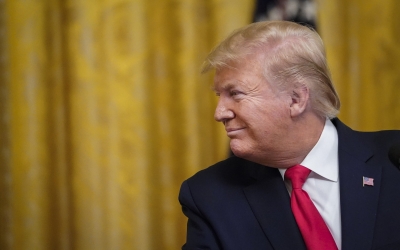
Despite presenting a plan that was preemptively and categorically rejected by Palestinian leadership, the Trump administration has still expressed hope that the proposal would lead to negotiations.
Should such negotiations take place, the United States commits to implementing a certain number of moves “to the extent permitted by law” as a gesture of goodwill towards the Palestinians.
Those moves include the reopening of the Palestine Liberation Organisation (PLO) office in Washington; the opening of a US liaison mission to the PA; the resumption of US aid to the occupied Palestinian territories; and efforts to support international infrastructure projects.
The PLO office was closed by the US in September 2018; US funding for UNRWA, the United Nations agency for Palestinian refugees, was cut off completely in August that same year; and USAID funding to projects in the occupied territories suffered a similar fate in February 2019.
In effect, the moves would not so much bring new benefits to Palestinians, as simply roll back decisions that were taken since Trump came to power.
15. What is Israel conceding?
Trump has said it over and over again: a good deal requires compromises. The “deal of the century” has already been slammed for demanding that Palestinians give up East Jerusalem, large swathes of the West Bank, the right of return and compensation for refugees, justice through international bodies, to name a few.
After reading the full plan, Middle East Eye can provide a complete list of what Israel has agreed to concede to Palestinians in exchange:
- Transferring two areas of arid land in the Negev desert
- Freezing settlement expansion in areas “eyed for a Palestinian state” for four years
- Contemplating the “possibility” of transferring the Northern Triangle populated by Palestinian citizens of Israel
- Remaining withdrawn from territories it occupied in 1967 and has since left. “Withdrawing from territory captured in a defensive war is a historical rarity” which “must be recognised”, the plan states. The statement likely refers to the return of the Sinai Peninsula to Egypt in 1982, transfer of control of Areas A and B to the PA following the 1993 Oslo Accords, and settler evacuation from Gaza in 2005
- Fully funding the Israeli forces that will maintain “overriding security control” over the fledgling Palestinian state (See item 7 on this list)
- Granting temporary, supervised use of port facilities at Haifa and Ashdod for trade
- Halting demolitions of Palestinian properties - except for punitive home demolitions, a policy Palestinians have repeatedly denounced.
It is up to our readers to decide if the Trump administration has indeed come up with a “fair compromise”.
Middle East Eye propose une couverture et une analyse indépendantes et incomparables du Moyen-Orient, de l’Afrique du Nord et d’autres régions du monde. Pour en savoir plus sur la reprise de ce contenu et les frais qui s’appliquent, veuillez remplir ce formulaire [en anglais]. Pour en savoir plus sur MEE, cliquez ici [en anglais].


